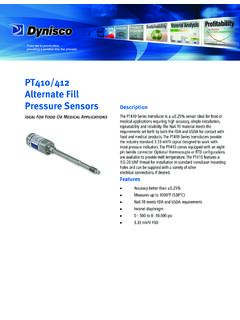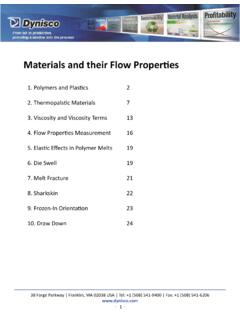Transcription of The Dynisco Extrusion Processors Handbook
1 TheDyniscoExtrusionProcessorsHandbook2nd editionWritten by:John Goff and Tony WhelanEdited by:Don DeLaneyAcknowledgementsWe would like to thank the following people for their contributions to this latest editionof the Dynisco Extrusion Processors Handbook . First of all, we would like to thank JohnGoff and Tony Whelan who have contributed new material that has been included in thisnew addition of their original book. In addition, we would like to thank John Herrmann,Jim Reilly, and Joan DeCoste of the Dynisco Companies and Christine Ronaghan andGabor Nagy of Davis-Standard for their assistance in editing and publication. For the fig-ures included in this edition, we would like to acknowledge the contributions of Davis-Standard, Inc., Krupp Werner and Pfleiderer, Inc., The Dynisco Companies, Dr. HaroldGiles and Eileen 1: INTRODUCTION TO EXTRUSIONS ingle-Screw Extrusion .
2 1 Twin-Screw Extrusion ..3 Extrusion Processes ..6 Safety ..11 SECTION 2: MATERIALS AND THEIR FLOWPROPERTIESP olymers and Plastics ..15 Thermoplastic Materials ..19 Viscosity and Viscosity Terms ..25 Flow Properties Measurement ..28 Elastic Effects in Polymer Melts ..30 Die Swell ..30 Melt Fracture ..32 Sharkskin ..34 Frozen-In Orientation ..35 Draw Down ..36 SECTION 3: TESTINGT esting and Standards ..37 Material Inspection ..40 Density and Dimensions ..42 Tensile Strength ..44 Flexural Properties ..46 Impact Strength ..47 Hardness and Softness ..48 Thermal Properties ..49 Flammability Testing ..57 Melt Flow Rate ..59 Melt Viscosity ..62 Measurement of Elastic Effects ..64 Chemical Resistance ..66 Electrical Properties ..66 Optical Properties ..68 Material Identification ..70 SECTION 4: THE SCREW AND BARREL SYSTEMM aterials Handling.
3 72 The Hopper ..75 The Barrel ..76 The Screw ..79 Screw Types ..83 Screw Mixing Sections ..87 Breaker Plates, Screen Packs, and Gear Pumps ..92 Screw Drive System ..96 Motor Size and Thrust Bearing Life ..99 SECTION 5: THE DIE AND POST EXTRUSIONEQUIPMENTDie Design Criteria ..101 Materials of Die Construction ..103 Die Heating ..105 Flat Film and Sheet Dies ..107 Blown Film Dies ..108 Pipe Dies ..111 Wire and Cable Covering Dies ..113 Profile Dies ..114 Cooling ..115 Extrudate Take Up ..116 Cutting and Stacking ..118 SECTION 6: Extrusion OPERATIONSS tart Up ..119 Process Monitoring ..122 Process Control ..127 Shut Down Procedures ..130 Purging ..130 Stripping and Cleaning ..133 Reclaimed Material ..136 Machine Setting and Running ..139 SECTION 7: DEFECTS AND DEFECT FINDINGD efect Determination ..143 Minimizing Defects.
4 145 Extrusion Defects and Causes ..146 Production Problems and Flow Behavior ..147 SECTION 8: GUIDELINES FOR THE FOLLOWINGMATERIALSABS (Acrylonitrile-Butadiene-Styrene) ..150 HIPS (High Impact Polystyrene) ..159PA 6 (Nylon 6) ..165PA 66 (Nylon 66) ..175 LDPE (Low Density Polyethylene) ..183 LLDPE (Linear Low Density Polyethylene) ..191 HDPE (High Density Polyethylene) ..198PP (Polypropylene) ..206 PMMA (Polymethyl Methacrylate) ..216 PPVC (Plasticized Polyvinyl Chloride) ..223 UPVC (Unplasticized Polyvinyl Chloride) ..234 SECTION 9: USEFUL INFORMATIONSI Units Advice on Use ..245 Unit Conversion ..246 Temperature Conversion ..251 Thermocouple Selection ..251 Applications of Rheological Data for Extrusion ..254 Material Property Guidelines ..260 Glossary of Extrusion Terms ..262 Book List ..284 LIST OF TABLEST able Abbreviations (Based on ISO and ASTM)for Selected Thermoplastics.
5 17 Table 2. Common Abbreviations and Trade Names/Trademarks for Extruded Thermoplastics and Thermoplastic Elastomers ..22 Table Tests Used for Property Guidelines ..39 Table Content Limits for Extrusion ..42 Table (Mold Shrinkage) Values for SomeThermoplastic Materials ..51 Table Specific Heat and Heat Content forSome Thermoplastic Materials ..52 Table Transition Temperatures (Tg) and Melting Temperatures (Tm) for Some Thermoplastic Materials ..53 Table Thermal Properties of SomeThermoplastic Materials ..55 Table of Softening Temperatures forSome Thermoplastic Materials ..56 Table Limiting Oxygen Index (LOI) Results ..57 Table Results from the UL 94 VerticalBurning Test ..58 Table Temperatures ( C) and Loads (Kg)for MFR Tests ..61 Table Temperatures for HighShear Rate Rheometry ..63 Table Drying Conditions for ExtrusionMaterials.
6 74 Table Contents of Some Thermoplastic Materials ..116 LIST OF FIGURESF igure Screw Extruder ..2 Figure Screw Extruder ..4 Figure Pump ..6 Figure Extrusion ..7 Figure Film Extrusion ..7 Figure and Film Extrusion ..8 Figure Coating ..9 Figure Curves for Some Commodity Thermoplastics ..27 Figure Curves for Some Engineering Thermoplastics ..27 Figure Rheometer ..29 Figure Swell ..31 Figure Fracture ..33 Figure Flow Rate Tester ..59 Figure Basic Extrusion Screw ..80 Figure Melting on the Extrusion Screw ..80 Figure Profiles in the Extruder ..81 Figure 16. Elements of an Extrusion Screw ..82 Figure and Parallel Screws ..83 Figure Screw Designs ..85 Figure Compression Screw (Variable Pitch) ..86 Figure Two Stage Screw for Venting ..86 Figure Mixing ..88 Figure Mixing Sections.
7 88 Figure Mixing Sections ..89 Figure Mixing Sections ..90 Figure Mixer ..91 Figure Plate and Screen Packs ..93 Figure Changers ..94 Figure Plate and Screen Pack Clamp Assembly ..95 Figure Gear Pump System ..96 Figure Film and Sheet Dies ( T , Coathanger) ..107 Figure Film Die ..109 Figure Die ..111 Figure Wire and Cable Die ..113 Figure Transducers ..122 Figure s Pressure Gauges, Transducers and Transmitters ..123 Figure ..124 Figure s Melt Thermocouples ..124 Figure s ATC770 Pressure/Process Controller ..129 Figure Flow Curves Used for theDetermination of w ..255 Figure Factors for Rectangular Dies ..256 Figure Flow Curves Shown as Viscosity vs. Shear Rate ..257 Figure Through a Die for a Newtonian Fluid and Polymer Melt ..258 Figure Rates in a Die for a Newtonian Fluid and Polymer Melt.
8 259 SECTION 1:INTRODUCTION TO Extrusion SINGLE SCREW Extrusion TWIN SCREW Extrusion Extrusion PROCESSES SAFETY SINGLE SCREW EXTRUSIONE xtrusion may be defined as a process for making a product (an extrudate) byforcing a material through an orifice or die to form a shape, or alternatively,the production of finished, or semi-finished products, using an of the HandbookThis book will be mainly concerned with the Extrusion of thermoplastic prod-ucts because of their importance in Extrusion processes. Thermoplastics areby far the largest group of plastic materials extruded; approximately 65% of allplastics pass through an extruder. As the most popular type of extruder is thesingle screw machine, this book will mainly concentrate on processes basedon that type of machine. Single screw machines are the most popular becausethey are relatively simple, cheap and easily give a continuous and ThermoplasticsIn Extrusion of a thermoplastic, heating first softens the material so that it canbe shaped.
9 The Extrusion machine, or extruder does this process. This heatsoftening is called by various names, such as plastication , plasticization or thermal softening . Most extruders are single screw machines. It is the screwwhich forces the material towards, and then through, the die. Shape is impart-ed by the die, and/or by post- Extrusion forming, and then the product is set toshape by cooling it while maintaining its shape. The equipment that does thisis called the post Extrusion equipment, while the whole system is called anextrusion ClassificationExtruders may be classified by three figures, for example, 1-60-24. The firstnumber states how many screws the machine has, the second number speci-fies the screw diameter in millimeters (mm) and, the third number specifiesthe effective screw length as a multiple of the screw diameter. In the examplegiven therefore, a single screw machine is being described that has a screw ofdiameter 60 mm and a length of 24 screw diameters (that is, a L/D ratio of24/1).
10 Machine ConstructionA cut-away drawing of a simple single screw machine is shown in Figure shows the arrangement of the different parts of the machine. The screwand barrel are the two units that interact to convey the plastic material, meltthe material and then force it through the die. The electric motor drive unit andgearbox rotate the screw at a predetermined speed. Temperature controllers1section 1: introduction to extrusionare connected to heating/cooling elements on the barrel to hold the tempera-ture at the set-point temperatures. The ability of the screw and barrel assemblyto extrude a given material is dependent on the characteristics of the plasticsmaterial, the characteristics, or construction, of the screw and barrel, and theconditions under which the system is 1. Single Screw Extruder (courtesy of Dr. Harold Giles)Post Extrusion EquipmentOnce the extrudate leaves the die it can either be set to the shape to be pro-duced or have its shape altered and then set to shape.









